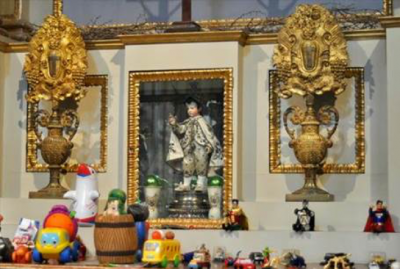 On Wednesday, April 20th, Professor Daniel Hershenzon delivered a presentation titled “Redemption and Contentious Objects in the Early Modern Mediterranean” as part of LCL’s Faculty Lecture Series. Hershenzon talked about the distribution and redistribution of religious images across the early modern Mediterranean as partly engendered by the circulation of Christian and Muslim captives in the same place and time. Focusing on paintings and sculptures of Jesus, Mary, and the saints, Hershenzon spoke about the mobility and economy of religious items trafficked between North Africa and the Iberian peninsula, highlighting instances of iconoclasm, objectification, and
On Wednesday, April 20th, Professor Daniel Hershenzon delivered a presentation titled “Redemption and Contentious Objects in the Early Modern Mediterranean” as part of LCL’s Faculty Lecture Series. Hershenzon talked about the distribution and redistribution of religious images across the early modern Mediterranean as partly engendered by the circulation of Christian and Muslim captives in the same place and time. Focusing on paintings and sculptures of Jesus, Mary, and the saints, Hershenzon spoke about the mobility and economy of religious items trafficked between North Africa and the Iberian peninsula, highlighting instances of iconoclasm, objectification, and  commodification of such articles as they were repurposed outside of the cultural sphere in which they were created. The talk began with a demonstrative example from – of all places – contemporary Mexico, where a a sculpture of Baby Jesus attributed to the Sevillan artist Juan Martínez Montañez has resided since the early 17th century. This sculpture, an icon of salvation for addicts and kidnapping victims in recent times, was captured en route to Mexico from Spain and held for 6 years in Algiers, before finally being ransomed and arriving safely at its destination. Hershenzon explained that he chose to frame the presentation using this example because it exemplifies the dynamic history of similarly captured images, and “demonstrates the unique long-term reciprocal relation and continuous reversal of roles between god and believers, redeemeers and captives.”
commodification of such articles as they were repurposed outside of the cultural sphere in which they were created. The talk began with a demonstrative example from – of all places – contemporary Mexico, where a a sculpture of Baby Jesus attributed to the Sevillan artist Juan Martínez Montañez has resided since the early 17th century. This sculpture, an icon of salvation for addicts and kidnapping victims in recent times, was captured en route to Mexico from Spain and held for 6 years in Algiers, before finally being ransomed and arriving safely at its destination. Hershenzon explained that he chose to frame the presentation using this example because it exemplifies the dynamic history of similarly captured images, and “demonstrates the unique long-term reciprocal relation and continuous reversal of roles between god and believers, redeemeers and captives.”